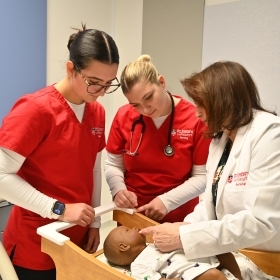Navigating the FAFSA® 2024–25: Top Changes to Know

Are you a current or incoming student preparing for the upcoming 2024–25 academic year? Here’s some exciting news for you! The Free Application for Federal Student Aid (FAFSA®) has undergone significant changes that promise a more seamless and user-friendly experience.
This blog post will discuss the significant changes made to the FAFSA® and what they mean for your eligibility for federal financial aid.
Top FAFSA® Changes for 2024–25
I. Changes to the FAFSA® Form
A Shorter, Dynamic Application
Applicants now encounter a more user-friendly experience with a significant reduction in questions. The application is tailored to each individual, potentially resulting in even fewer questions, for some as few as 18 questions, according to Federal Student Aid. Questions about housing, Selective Service registration, and drug convictions have been removed.
Child Support Is an Asset.
One of the significant changes in the FAFSA® 2024–25 application is that child support is now classified as an asset rather than income.
Family Size Is Based on Tax Return Data.
The FAFSA® 2024–25 application now imports family size based on dependents claimed on federal tax returns. However, the FAFSA® allows the family size to be adjusted if the tax return data does not reflect the student’s current family size.
II. Changes to the FAFSA® Process
Send FAFSA® to 50 Percent More Colleges.
Previously, students could only list up to 10 schools on their FAFSA® application. The FAFSA® 2024–25 application now allows applicants to include up to 20 colleges and universities, expanding options and aiding informed decision making.
The Transfer of Tax Data Is Automated.
Beginning with the 2024–25 application cycle, all FAFSA® users must consent to transferring federal tax information. This eliminates the need for most applicants and contributors to self-report income and tax information reported to the Internal Revenue Service (IRS).
It’s important to note that there may still be situations where taxpayers must manually enter their tax information, even if they have already filed their federal tax return with the IRS.
“Contributors” are Now on the 2024–25 FAFSA® Application.
In the latest FAFSA® application for 2024–25, a new term, “Contributor,” is introduced. A Contributor is anyone required to give information on the applicant’s form, like the student, their spouse, a biological or adoptive parent, or a stepparent.
Here are the critical changes for all contributors:
- The person providing the most financial support to the student must now complete the FAFSA®, unlike before when it was based on the parent the student lived with the most in the last 12 months.
- If parents file joint federal tax returns, only one parent’s FSA ID is needed to sign the FAFSA®.
- Each Contributor, including unmarried individuals living together and married individuals filing separate tax returns, must have their own FSA ID.
III. Changes in Aid Calculation
Introduction of the Student Aid Index (SAI)
The Expected Family Contribution (EFC) has been replaced with the Student Aid Index (SAI). The financial aid offices of colleges and universities use SAI to assess and determine the federal student aid amount a student can receive.
Apart from the name change, various significant differences exist in the formula used to calculate the need for financial aid. For instance, the number of family members in college is no longer a factor in need analysis. Moreover, an updated minimum SAI of -1500 is required for higher financial needs. Lastly, Pell Grant eligibility is determined based on family size and federal poverty levels.
Expanded Pell Grant Eligibility
According to the US Department of Education, including family size and federal poverty levels in the calculation of Pell Grant eligibility can help more than “610,000 low-income students become eligible to receive the Federal Pell Grant.” Around “1.5 million more students will also qualify for the maximum Pell Grant.”
Unchanged Aspects of FAFSA® 2024–25
While FAFSA® evolves, key elements remain consistent, ensuring a fair assessment of federal, state, and university need-based aid. This includes
- The FAFSA® still must be completed every year.
- Prior-year federal income tax information is used to determine aid eligibility.
- Federal College Work Study earning are still excluded from the need analysis calcuation.
- Family with special circumstances, such as loss of income/benefits or death of a parent/spouse, may be considered seperarately by financial aid counselors.
- The questions determining whether parents need to prove their information on the FAFSA® remain the same.
- Students who file the FAFSA®, do not default on their previous loans, do not owe a federal refund, and meet all program eligibility requirements remain eligible for federal student loans.
When does FAFSA® open for 2024–25?
The new FAFSA® for 2024–25 is now available. It has started as a soft launch to provide a smoother application experience for students and families. Please visit this student aid webpage for more information on the FAFSA® soft launch.
While Federal Student Aid has commenced its “soft launch” of the 2024–25 Free Application for Federal Student Aid (FAFSA®), there may be delays and glitches. Administrators in Student Financial Services at St. John’s University are hearing from students that once they get in, the form is more accessible to complete. Visit studentaid.gov to apply.
St. John’s University Strives to Makes a World-Class Education Affordable
St. John’s University offers generous scholarships and financial aid. Explore the Data from the St. John’s 2022–23 Academic Year:
99% of first-year students recieved aid.
First-year students received more than $120 million in grants, scholarships, and loans.
More than $20.5 million in Federal Pell Grants were recieved by undergraduate students
$83 million in total institutional aid ( a subset of total aid) was recieved by first-year students from St. John's.
St. John’s Federal School Code for the FAFSA is 002823.
Please note that St. John’s, like all other higher education institutions, will not begin to receive completed 2024–25 FAFSA® applications until the end of January or the beginning of February.
Managing Change Together
Federal Student Aid, high schools, and colleges alike stand ready to embrace this change. In light of all the changes to the FAFSA®, St. John’s University’s Office of Student Financial Services has created this web page as a helpful resource. The Student Financial Services team understands that the financial aid process can be overwhelming and continues to look for ways to help students and their families navigate the new process.






